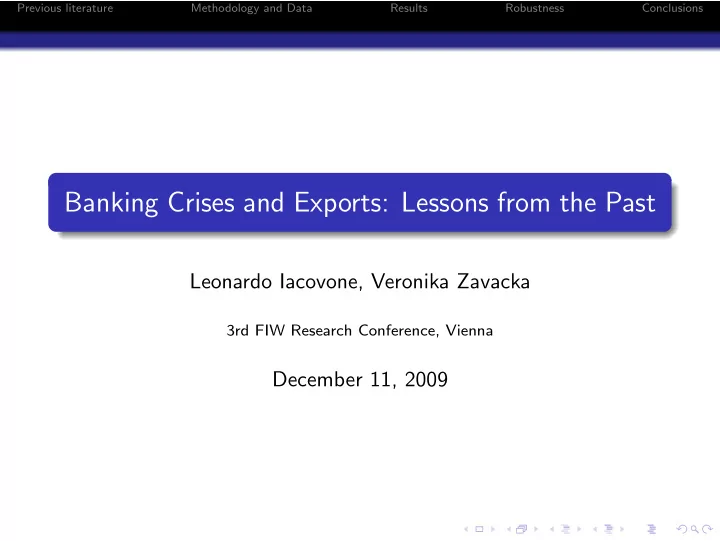

Previous literature Methodology and Data Results Robustness Conclusions Banking Crises and Exports: Lessons from the Past Leonardo Iacovone, Veronika Zavacka 3rd FIW Research Conference, Vienna December 11, 2009
Previous literature Methodology and Data Results Robustness Conclusions Motivation Unprecedented drops in trade volumes following the unfolding of the financial crisis large drops in demand particularly in developed economies Questions: 1 How much of the observed reduction in trade is attributable to supply side effects (i.e. finance)? 2 Can we disentangle the supply side effect of the crisis from the demand side effect?
Previous literature Methodology and Data Results Robustness Conclusions Agenda Previous literature 1 Methodology and Data 2 Results 3 Robustness 4 Conclusions 5
Previous literature Methodology and Data Results Robustness Conclusions Previous literature 1 Impact of financial distress on the real economy Dell’Ariccia et al. 2008, Berman 2008, Borensztein and Panizza 2009, Braun and Larrain 2005 2 Financial development and growth finance and production (Rajan and Zingales 1998, Fisman and Love 2003, Braun 2003) finance and exports (Beck 2002, Beck 2003, Manova 2008) 3 Firm level literature on financial constraints of exporters theory (Kletzer and Bardhan 1987, Baldwin 1989, Krugman 1989) empirics (Roberts and Tybout 1997, Iacovone and Javorcik 2008, Muuls 2008)
Previous literature Methodology and Data Results Robustness Conclusions Methodology - estimation equation Methodology difference in difference a la Rajan and Zingales (1998) reduces the issues of endogeneity and ommitted variables Estimation equation ∆ X ijt = α ij + β it + γ jt + φ Share ijt − 3 + δ ExtFinDep j ∗ Crisis it + λ DemShock ijt + ǫ ijt ∆ X ijt is the (ln) growth rate of exports α ij is the country-industry fixed effect (long-term growth control) β it is the country-year fixed effect (country specific shocks) γ jt is the industry-year fixed effect (global industry specific shocks) Share ijt − 3 is the share of industry in total exports (convergence effects)
Previous literature Methodology and Data Results Robustness Conclusions Data Trade data Gross exports from UN Comtrade for period 1980-2006 ISIC revision 2, disaggregated to 4 digit level Banking crises based on Dell’Ariccia et al 2008 who identify systemic crises when Emergency measures taken to assist the banking system Large scale nationalization took place NPLs reached at least 10% in total assets Cost of rescue operation more than 2% of GDP 23 episodes in 21 developed and developing countries after excluding twin crises
Previous literature Methodology and Data Results Robustness Conclusions Data - Financial measures All measures based on US firm level data from Compustat 1980-1990 Dependence from bank finance (Rajan and Zingales 1998) Industry level median of ratio of capital expenditures minus cash flow over capital expenditures Dependence on inter-firm finance (Fisman and Love 2003) Industry level median of ratio of accounts payable over total assets Tangibility (Kroszner et al. 2007) Industry level median of ratio of tangible assets in total assets
Previous literature Methodology and Data Results Robustness Conclusions Main results: Benchmark regressions (1) (2) (3) (4) Trade share -0.680*** -0.679*** -0.674*** -0.676*** (0.115) (0.115) (0.115) (0.115) RZ*Crisis -0.0536*** -0.0354* (0.0171) (0.0181) FL*Crisis 0.203 -0.240 (0.351) (0.366) TANG*Crisis 0.199*** 0.175*** (0.0543) (0.0583) Constant -0.153 -0.163 -0.160 -0.235 (0.143) (0.131) (0.135) (0.154) Observations 30753 30753 30753 30753 R-squared 0.275 0.275 0.275 0.275 Robust standard errors in parentheses ***, **, * significant at 1%, 5%, 10%
Previous literature Methodology and Data Results Robustness Conclusions Main results: Demand shocks (1) (2) (3) (4) (5) Trade share -0.673*** -0.668*** -0.675*** -0.669*** -0.670*** (0.111) (0.114) (0.114) (0.114) (0.114) Demand shock 0.0118*** 0.00790*** 0.0227*** 0.0185*** 0.00551** (0.00198) (0.00231) (0.00833) (0.00475) (0.00241) RZ*Crisis -0.0480*** -0.0418** (0.0170) (0.0172) RZ*Demand shock 0.0144*** 0.0110*** (0.00397) (0.00406) FL*Crisis 0.129 (0.352) FL*Demand shock -0.120 (0.0871) TANG*Crisis 0.192*** (0.0544) TANG*Demand shock -0.0214 (0.0136) Durables*Crisis -0.0162 (0.0121) Durables*Demand shock 0.00848*** (0.00307) Constant 0.0239 -0.0471 0.144* -0.305* -0.254 (0.0707) (0.150) (0.0783) (0.157) (0.161) Observations 31980 30753 30753 30753 30753 R-squared 0.274 0.277 0.276 0.277 0.277
Previous literature Methodology and Data Results Robustness Conclusions More results.. 1 Deepness of the crisis using GDP loss as a proxy for deepness of a crisis we show that the adverse effect on highly dependent sectors is stronger in deeper crises 2 Effect of financial development and GDP more developed countries tend to do better probably because of better access to other forms of finance and to foreign banks 3 Effect of policies general policy interventions targeted at easing the situation of the banks (blanket guarantee, liquidity support, debt relief etc.) do not have a significant effect on exports performance
Previous literature Methodology and Data Results Robustness Conclusions Robustness tests is banking crisis like any economic distress? are our measures of financial dependence/tangibility suitable? are we measuring something else? what about omitted variables? are results driven by a certain country or certain group of countries? are our results driven by the choice of methodology? what about endogeneity?
Previous literature Methodology and Data Results Robustness Conclusions Conclusions Main results exporters get hurt through the financial channel in banking crisis industries highly dependent on external finance grow less highly tangible industries grow faster in a crisis demand shocks work on top of the supply shocks better economic and financial development helps mitigate the effect on exporters Implications effects of finance on exporters should not be underestimated governments could potentially implement schemes to ease access to finance
Previous literature Methodology and Data Results Robustness Conclusions Thanks Thank you
Recommend
More recommend